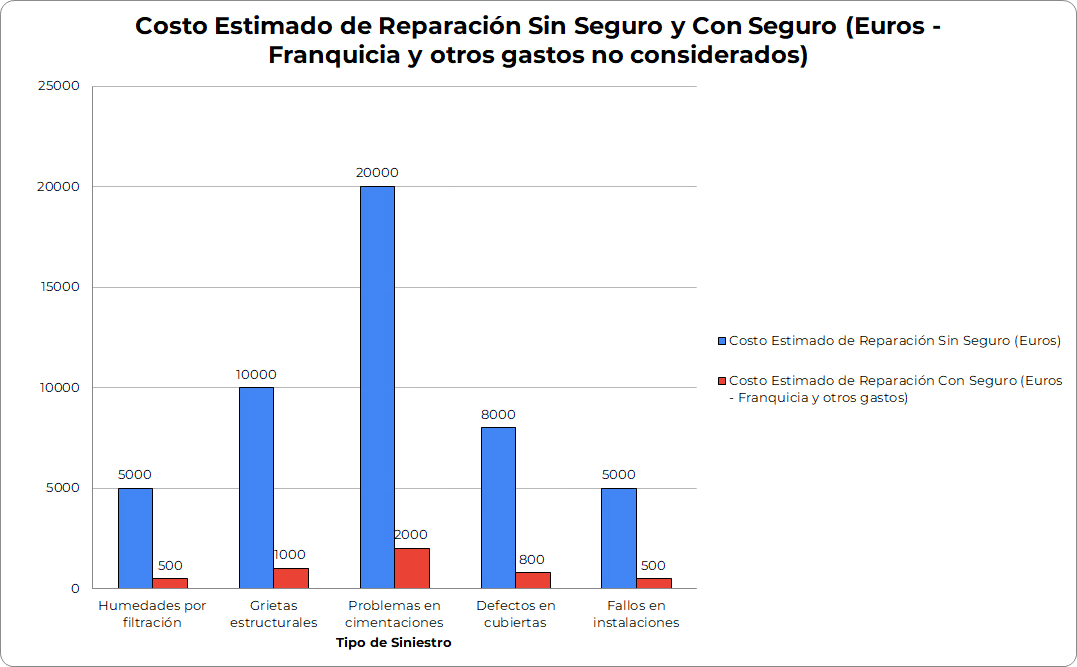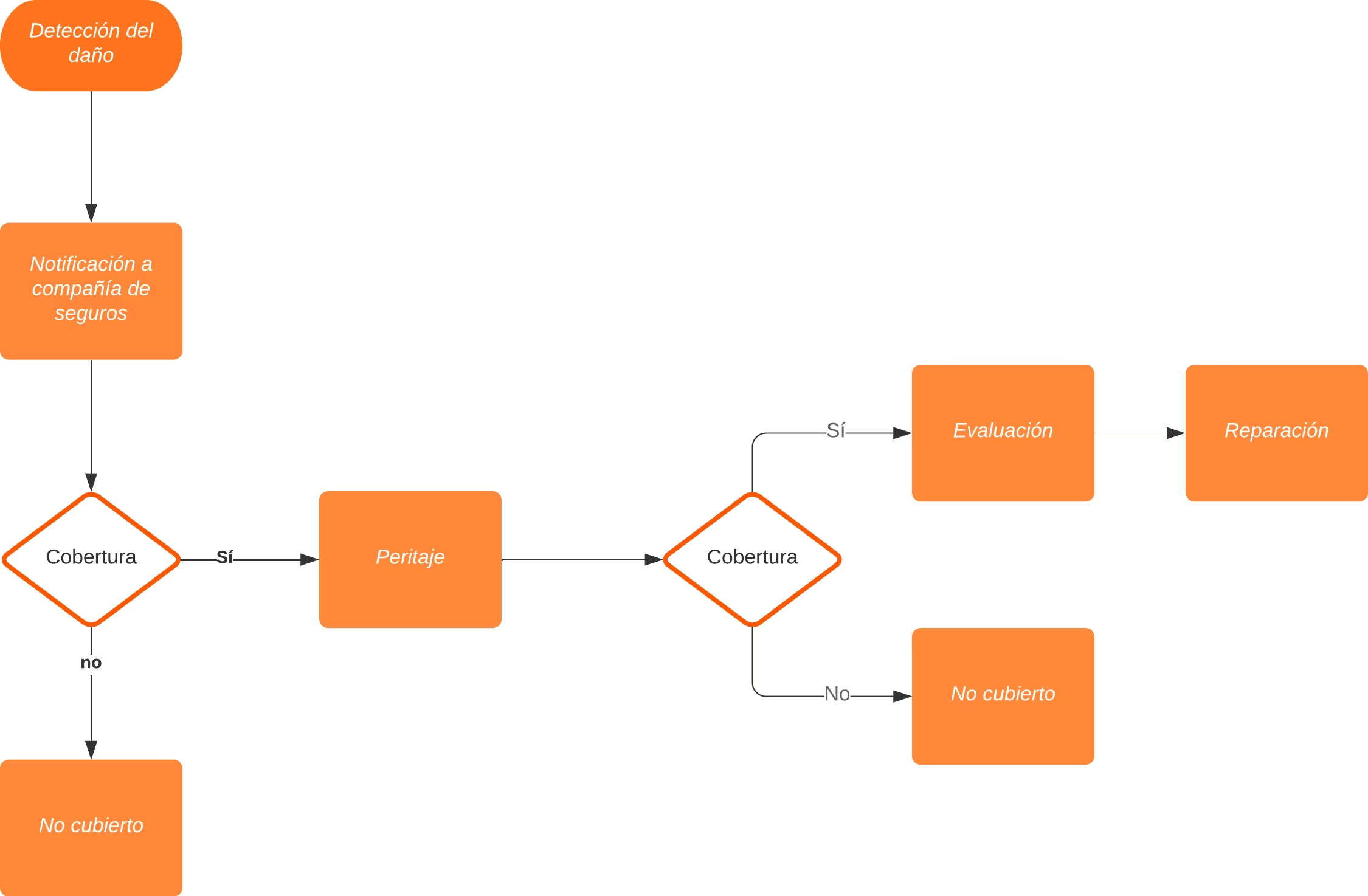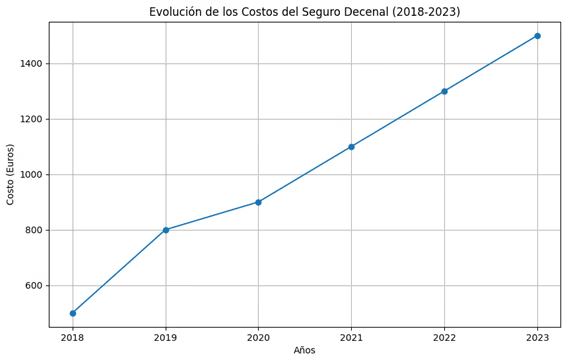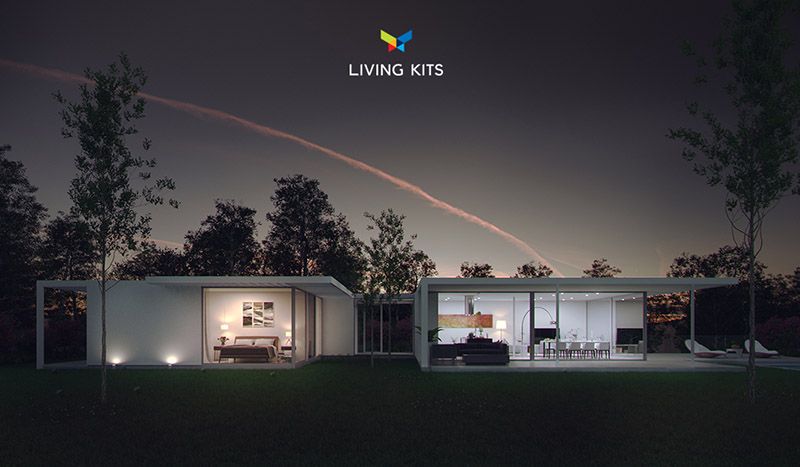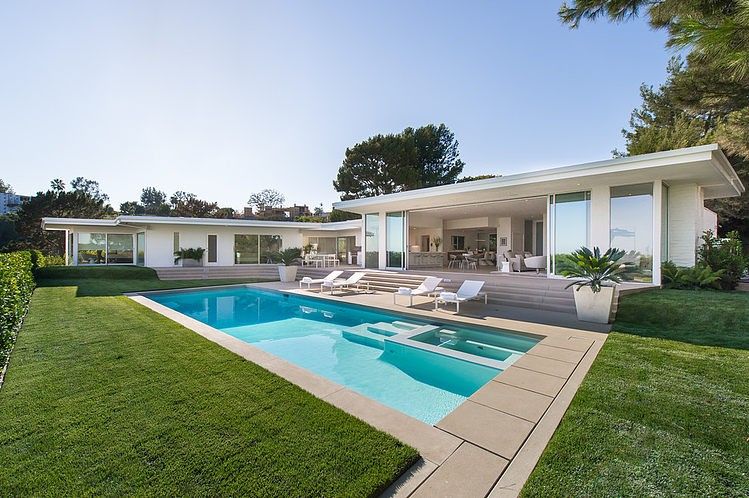The 10-Year Building Warranty Insurance it is very important in the Spanish real estate sector. Acts as a guarantee to protect the investment in new properties. This specialized policy protects the owners and developers of possible structural defects that may appear during the first ten years after construction is completed.
The 10-Year Building Warranty Insurance it is mandatory for all new buildings dedicated to housing, which demonstrates its importance. This is due to the structural damage can compromise the safety of the inhabitants and decrease the value of the property.
In the complicated world of construction, where each project has many variables and risks, the 10-Year Building Warranty Insurance it has three important functions:
- Protects the financial investment of the buyers
- Ensures construction quality of the building
- Facilitates the resolution of conflicts related to structural defects
This insurance is even more important because the structural problems usually appear gradually and may require costly repairs. Therefore, it is essential to understand their characteristics, coverage and benefits to any owner, developer or prospective buyer of a new home.
In this post, we delve into:
What is the Ten year Insurance and Why is it Mandatory?
The ten year insurance is a guarantee that protects the owners and developers of new homes against structural defects during the first ten years after construction is complete. This policy is set according to the Law 38/1999 Management of the Building (LOE).
The 10-Year Building Warranty Insurancealso known as damage insurance decennial or ten-year guarantee, is an insurance policy that is specific to the construction sector. As its name suggests, provides coverage for a period of ten years from the date of receipt of the work.
The importance of protecting your investment in a new construction could not be underestimated. During the first years, can arise structural defects or construction problems that require costly repairs.
The ten year insurance provides peace of mind to the owner or promoter to cover the costs associated with these problems, thus avoiding a significant financial burden.
Main features of the ten year insurance:
- Covers property damage caused by defects or structural defects
- Protects the stability and mechanical strength of the building
- Guarantee the repair or compensation of damages covered
- Includes the costs of demolition, if necessary
When is it mandatory the ten year insurance?
The ten year insurance is compulsory in the following cases:
- Construction of new homes
- Rehabilitation, comprehensive
- Real estate for sale
- Air intended for sale in 10 years
Exceptions to the obligation:
- Not required ten year insurance in the following cases:
- Self-promotion for own use (with specific requirements)
- Public buildings
- Industrial buildings
- Reforms partial
The recruitment process for a ten year insurance involves the intervention of a Body of Control Technician (OCT), although there are options ten year insurance without OCT for specific situations. It is important to note that the policy must be active prior to the entry of the new work on the Registration of the Property.
Self-Builders may request an exemption from the insurance if they meet the following conditions:
- Allocated housing to their own use
- Hold the property for 10 years
- Record this circumstance in public writing
It is possible to employ the secure both during construction and for finished workbut the costs and requirements may vary depending on the time of the subscription.
Coverages of the Year Insurance: What Damages Are Protected?
The acquisition of a new home is one of the most significant capital investments that most people make in their life. The ten year insurance acts as a safety net, protecting this investment against structural defects that could compromise the integrity of the building.
The ten year insurance provides a specific protection against structural damage that can compromise the stability and security of the building. The basic coverages include:
1. Structural Damage Main:
- Defects in foundations and elements of sustainability
- Problems in beams and columns
- Failure in load-bearing walls
- Deterioration in forged structural
- Damage in elements of containment
2. Defects in Essential Elements:
- Failures in the waterproofing of decks
- Sealing problems in basements
- Deficiencies in the structure of facades
- Deterioration in the elements of bracing
The coverage is triggered when the damage:
- They have origin in defects of construction
- Affect the mechanical strength of the building
- Compromise the stability of the building
- Put at risk the safety of the occupants
Additional Coverages Optional:
- Reimbursement of expenses for demolition
- Costs of removal of debris
- Professional fees for repairs
- Damage to surrounding buildings
Supervision by an Office of Control Technician (OCT) is required to activate these coverages. This independent body performs:
- Review of the technical project, following the technical specifications for the construction
- Control of materials
- Supervision during the execution
- Verification of construction quality
The ten year insurance remains valid even if the construction company or developer disappears, while ensuring the protection of the owner during the 10 years of coverage established by law.
In addition, it is important to mention that the construction and real estate have civil liability to damages caused by structural defects, which further reinforces the importance of the ten year insurance.
Exclusions Common in Insurance Policies Decennial
It is crucial to know the limitations of the year insurance to avoid unpleasant surprises. Insurers set out specific exclusions that are not covered by the policy:
Damages not covered:
- Aesthetic defects and surface finishes
- Natural wear and tear of the materials
- Damage caused by modifications subsequent to construction
- Problems arising from misuse or lack of maintenance
- Gradual deterioration by environmental factors, normal
Situations excluded:
- Natural disasters extraordinary
- Acts of vandalism or terrorism
- Damage caused by fires or explosions
- Economic losses indirect
- Personal injury or damage to third parties
Technical aspects are not included:
- Installation of mechanical and electrical
- Elements removable or detachable
- Domestic appliance
- Enclosures mobile
- Gardens and landscaping
Companies such as Mapfre, Musaat and Asefa may offer additional coverage for some of these elements through specific plug-ins. The recruitment of these extensions will depend on the particular needs of each project and the budget available.
Who needs a Ten year Insurance?
The ten year insurance is relevant for various stakeholders in the process of construction and purchase of new housing:
Obligations of the developer and builder
According to the Law of Management of the Building (LOE), the promoter it is the main obliged to hire the year insurance. This includes both large developers like to selfbuilders building their own housing.
Benefits for the owner
Although the promoter is the one who contracts for insurance, the ultimate beneficiary is the owner of the home. This insurance provides peace of mind and financial protection for the long-term buyers of new homes.
Key benefits of the Ten year Insurance for Owners and developers
The ten year insurance provides multiple advantages that protect your real estate investment in the long term:
Financial Protection Integral
- Coverage of repair costs in case of structural defects
- Direct compensation without the need of judicial processes
- Financial support to any damages which may compromise the stability of the building
Security and peace of mind
- Quality assurance constructive backed by professionals
- Specialized technical supervision during construction
- Validation of building materials and processes
Additional Benefits
- Facilitates the future sale of the property
- Increases the value of the property on the market
- Simplifies obtaining mortgage financing
Professional Support
- Intervention of Offices of Control Technician (OCT)
- Supervision by architects certificates
- Continuous assessment during the construction process
The involvement of qualified experts in the process insurer guarantees a high-quality construction. The OCT perform thorough checks during the building, while the architects supervise every phase of the project. This network of professionals works together to minimize risks and ensure compliance of all standards of quality.
How does the Ten year Insurance?
The functioning of the year insurance involves several steps and considerations:
The claim process step-by-step
- Detection of the damage: The owner identifies a possible structural defect.
- Notice: it Is reported to the insurer about the damage detected.
- Expert opinion: The insurance company sends an adjuster to assess the damage.
- Evaluation: determines if the damage is covered by the policy.
- Repair: If it is covered, the insurer is responsible for the repair or compensation.
Deadlines and required documentation
- The deadline to make a claim is two years since that damage is detected, always within the period of ten years of coverage.
- It is crucial to keep all documentation related to the purchase of the property and the ten year insurance.
Process of Expertise in Insurance Claims
The expertise in the event of an insurance claim is a crucial process to determine the cause and extent of the damage, as well as the corresponding compensation.
Below, we detail how to perform this process:
- Designation of the Expert:
The insurance company appoints an expert specialized to evaluate the claim. This expert may be independent or employed by the insurer.
- Ocular Inspection:
The expert made a visit to the scene of the accident to directly observe the damage. This inspection is crucial to gather visual evidence and understand the circumstances of the incident.
- Data collection:
Collecting all the relevant data, including previous reports, technical documentation, contracts and any other information that might influence the evaluation of the loss.
- Description of Damage and Causes:
The expert produces a detailed report that describes the damage observed and discusses the possible causes. This analysis helps to determine if damages are covered by the insurance policy.
- A proposal for Action and Economic Valuation:
In the expert report, the expert proposes solutions to repair the damage and estimated the economic cost of these repairs. This assessment is key to calculate the compensation that corresponds to the insured.
- Expert's Report:
The result of the survey is reflected in an expert report, which is an official document reflects the expert's conclusions about the accident. This report is essential for any insurance claim, as it provides an objective basis, and for the professional evaluation of the case.
- Resolution of Discrepancies:
If the insured does not agree with the conclusions of the expert report, you can request a counter-expertise, or have recourse to the courts to resolve the dispute.
- Use of Advanced Technology:
In some cases, you can use video expertise to perform evaluations remote, which allows the expert to verify the damage without physically being present at the scene of the accident.
The expert report is essential not only to determine the appropriate compensation but also to provide a strong foundation in case of legal disputes between the insured and the insurer.
Factors that influence the cost of a Ten year Insurance
Various elements can affect the price of an insurance policy year:
Size of the work and complexity
Naturally, larger buildings or with more complex designs will have higher premiums. The cost of a ten year insurance can vary significantly depending on these factors.
Geographic location
The area where it is built, the building may influence the cost, considering factors such as the seismic risk or soil conditions.
Additional coverages
Add toppings extra to the basic policy will increase the cost of insurance. It is important to carefully evaluate what additional coverages are necessary for each specific project.
Duration and Cost of the Ten year Insurance: What You Need to Know
The ten year insurance maintains a fixed duration of 10 years from the date of receipt of the work, laid down in the act of reception. This period is considered critical to the detection of structural defects significant.
Factors that Determine the Cost
The price of a ten year insurance varies depending on several elements:
Total value of the building
- Buildings up to 300,000€: 0.65% – 0.80%
- Buildings above: 0.55% – 0.70%
Type of construction
- Single-family housing: 0.60% – 0.75%
- Multi-family building: 0.55% – 0.70%
- Self-promotion: 0.70% – 0.85%
Technical characteristics
- Structural complexity
- Quality of materials
- Construction methods employed
Additional Costs
The intervention of an Office of Control Technician (OCT) may involve an extra cost of:
- 4% – 0.6% for single family homes
- 3% – 0.5% for multifamily buildings
Variables Geographic
The location significantly influences the price:
- Seismic zones: Increase of 10-15%
- Land special: Increase of 5-20%
- Coastal areas: Rise of the 8-12%
Payment options
Insurers often offer two modes:
- Single payment at the start of the work
- Fractionation in installments during construction
The final cost can be optimized by recruiting early and the implementation of preventive measures during the construction process.
What happens if I don't have Ten year Insurance?
The lack of a ten year insurance may have serious implications:
Legal consequences and economic
- Inability to register the new work on the Registration of the Property.
- Difficulties to sell or mortgage the property.
- Personal responsibility of the promoter to possible structural damage.
It is important to note that can't sell a house without defects insurance during the first ten years after its construction, unless it is a case of a self promotion and buyer waive expressly to the seller of this obligation.
Tips for choosing a Ten year Insurance
Select year insurance right is crucial:
Comparative analysis of insurance companies
It is advisable to compare the offers from different companies. Some of the insurance companies more well-known, they offer decennial insurance are:
- Ten year insurance Mapfre
Mapfre is one of the leading insurance companies that offer decennial insurance in Spain. Your policy covers the legal requirements, and offers options for additional coverage.
- Musaat year insurance
Musaat is a mutual specializing in insurance for construction professionals, including decennial insurance.
- Asefa year insurance
Asefa is another company specializing in insurance of construction that offers insurance policies decennial adapted to different types of projects.
- Asemas year insurance
Asemas is a mutual insurance and reinsurance that provides decennial insurance among their products to the construction sector.
- Caser year insurance
Additional coverages to consider
Some policies offer toppings extra that may be valuableas the waterproofing of roofs or facades.
Options Available on the Market: Comparison between Insurers
The Spanish market offers a variety of options to hire the year insurance. The main specialised insurers have distinctive features in their coverage and services:
1. Mapfre
- Basic coverage from 0.55% of the value of the work
- Service expertise own
- Extensive network of offices for management, face-to-face
- Options for customization of additional coverages
2. Musaat
- Specialization in insurance for construction professionals
- Rates from 0.60% of the total value
- Management digitized paperwork
- Expert technical advice
3. Asefa
- Policies from 0.57% of the cost of the building
- Specific experience in large projects
- Recruitment process simplified
- Coverages complementary flexible
Differentiators by insurer:
| Insurer | Strong Points | Considerations |
| Mapfre | Financial strength and extensive network | Handling times longer |
| Musaat | Specialized care | Less physical presence |
| Asefa | Quickly in procedures | Network limited |
Key factors to compare:
- Base price of the policy
- Additional coverages available
- Process expertise
- Response time in accidents
- Ease of management of procedures
- Geographical presence
- Experience in the sector
The choice of carrier will depend on the specific characteristics of the construction project, the budget available and the particular needs of coverage. It is recommended to ask detailed budgets to several companies to perform an exhaustive comparison and select the option that best suits your requirements.
Specific types of Defects Insurance
Ten year insurance "autopromotor"
The 10-Year Building Warranty Insurance "autopromotor" it is designed specifically for individuals that build their own housing. Although it is not mandatory to selfbuilders that built for own use, it is strongly recommended, especially if there is the possibility of selling the home in the future.
Ten year insurance without OCT
Although less common, some insurers offer the possibility of hiring a ten year insurance without OCT (Agency for Technical Control). However, this tends to imply a process of assessment more rigorous by the carrier and may result in higher premiums.
Ten year insurance finished work
The ten year insurance finished work sign up for buildings already completed that, for some reason, I got the ten year insurance during construction. It is an option to deal with situations where the insurance will not be hired in his time.
Ten year insurance new work
The ten year insurance new work it is the most common type of defects insurance, contracted for new construction since the beginning of the project.
Ten year insurance-family housing
The ten year insurance-family housing it is specifically designed for individual houses, taking into account the particularities of this type of construction.
Differences between a ten year insurance for new work and finished work
The main differences between a ten year insurance for new work and finished work are:
- Time of recruitment:
- New work: Are contracted before or at the start of the construction.
- Finished work: will Be hired once the work.
- Evaluation process:
- New work: The insurer can assess the risks throughout the construction process.
- Finished work: Requires a technical inspection exhaustive of the building already constructed.
- Intervention of the Agency of Control Technician (OCT):
- New work: The OCT monitors the work from the start, performing periodic checks.
- Work completed: The OCT perform a comprehensive assessment of the building is complete.
- Cost of the policy:
- New work: is Usually more economical, since the risks are evaluated from the beginning.
- Finished work: is Usually more expensive due to the need for inspections more detailed.
- Coverage:
- New work: Covering all the structural elements from the start of construction.
- Finished work: focuses on the structural elements existing at the time of purchasing the policy.
- Ease of procurement:
- New work: More easy to obtain, since the insurer can monitor the whole process.
- Finished work: Might be more complicated, especially if it's been several years since the completion of the work.
- Documentary requirements:
- New work: Required to present the project and technical documentation, before starting the work.
- Finished work: Need documentation to verify the current state of the building, including certificates in order to work, and licenses.
- Flexibility in modifications:
- New work: Allows adjustments in the policy during the construction if there are changes in the project.
- Finished work: The policy is based on the building as-is, with less room for modifications.
- Start of coverage:
- New work: it Starts from the reception of the work.
- Finished work: it Starts from the procurement of the policy, but may have a waiting period.
- Risk assessment:
- New work: it Is based on projections and the design of the project.
- Finished work: it Is based on the evaluation of the construction already existing.
These differences make each type of insurance decennial adapt to specific situations, being the new work the most common and usually preferred by developers and builders, while the finished work serves as a solution for buildings that are not obtained insurance during construction.
The role of OCT in the Year Insurance
The Body Control Technician (OCT) plays a critical role in the process of the ten year insurance:
Functions of the OCT
- Performs a quality control during construction.
- Issued technical reports that the insurer uses to assess the risk.
- Helps prevent structural defects during the execution of the work.
OCT for ten year insurance
The intervention of an OCT is usually required by insurance companies as a condition for issuing the policy year insurance. The OCT for ten year insurance it is a key element in the process of underwriting.
Ten Year Insurance: Legal Aspects
How long is mandatory the ten year insurance?
The ten year insurance became mandatory in Spain, since the entry into force of the Law on Management of the Building in the year 2000.
Mandatory ten year insurance
It is mandatory for all new constructions are intended primarily to housing. However, there are some exceptions, such as single-family homes built by the owner (selfbuilder) for their own use.
Coverage of the Defects Insurance
What does it cover exactly the ten year insurance?
The ten year insurance covers physical damage to the building caused by faults or defects, which affect the mechanical strength and stability of the building. To know:
- Structural damage: This is the main coverage and mandatory. Includes property damage caused by defects that affect the mechanical strength and stability of the building. Specifically covers:
- Problems in foundations
- Defects in load-bearing structures
- Problems in walls, ceilings and floors
- Beams, floors and load-bearing walls defective
- Other structural elements that compromise the strength and stability of the building
- Defects that compromise the habitability, such as:
- Problems with the thermal insulation or acoustic insulation
- Defects in air-conditioning systems
- Faults in electrical installations, sanitary or plumbing
- Additional guarantees that some policies may include:
- Waiver of appeal against the contractor, planner and project management
- Revaluation capital
- Safe three-year leak-tightness of facades (3 years)
- Safe three-year waterproofing of facades and roofs (3 years)
Recruitment of the Ten year Insurance
How to hire a ten year insurance? To hire a ten year insurance, you must follow these steps:
- Contact several insurance companies specialized in decennial insurance.
- Provide detailed information on the construction project.
- Request and compare quotes.
- Choose an Agency of Control Technician (OCT) if required.
- Review and sign the policy.
Ten year insurance for Different Actors
Ten year insurance promoter
The promoter is the main obliged to hire the year insurance. This insurance protects your investment and comply with the legal requirements.
Ten year insurance construction
Although the obligation lies with the developer, some developers offer you to hire a ten year insurance as part of their services.
Ten year insurance architect
Architects are not required to hire the year insurance, but his work had a significant effect on the quality of the construction and, therefore, in the insured risk.
Evolution of the Costs of the Insurance and Ten-year (2018-2023)
The evolution of the insurance costs ten-year between 2018 and 2023 shows a clear upward trend, as can be seen in the graphic provided.
Some key points to note are:
- Sustained increase: The cost of the ten year insurance has increased steadily year after year, going from approximately 500 euros in 2018 at 1500 euros in 2023.
- Rate of growth: The increase has not been linear. We see growth more pronounced between 2018 and 2019, followed by increases more moderate in the years following.
- Economic impact: This significant increase in the costs of the ten year insurance has direct implications for developers and purchasers of new homes.
Factors that Influence the Cost of the Ten year Insurance
The cost of the ten year insurance depends on several key factors, including:
- Size and complexity of the project: Projects large or technically complex tend to have higher premiums due to the higher risks associated with them.
- Geographical location: The areas with the highest seismic risk or adverse weather conditions can also significantly increase the premiums.
- Body Control Technician (OCT): The intervention of an OCT is usually required by insurance companies to evaluate the technical quality during construction. Although their participation increases the initial cost, it can also reduce future risks and to ensure a better coverage.
- Additional coverages: Some policies offer coverage extra as cosmetic damage or additional waterproofing, which can increase the total cost.
Economic data relevant
- According to the sources consultedthe cost of the ten year insurance usually ranges between 0.37% and 1.0% of the value of the work.
- For a work of 600,000 euros, the cost of the OCT (Agency for Technical Control) may be between 1,200 and 1,700 euros, which is approximately a 0.28 percent of the value of the work.
- Translated into costs for housing, in a development of 6 houses, this would represent approximately 284 euros per household.
- The range of insurance costs ten-year it can vary widely, from 390 euros to 15,000 euros, depending on the type and size of the house.
- For a house valued at 300,000 euros, the average cost of a ten year insurance varies between 1,110 euros and 3,000 euros, depending on the type of coverage you purchase.
- On larger projects such as a residential or commercial building with a value in excess of 2 million euros, the premiums can easily exceed 15,000 euros, especially if you include additional coverages or if it is a complex work from a technical point of view.
- For residential buildings, the cost tends to be around 0.55 per cent on the value of the construction, while construction single-family can get to 0,70%.
The graph shows a steady increase in the costs of the ten year insurance from 2018 to 2023. Notes:
- A significant increase between 2018 and 2019, with an increase of about 300 euros.
- A more moderate growth but constant between 2019 and 2021.
- An acceleration in the increase of costs from 2021, with annual increases of around 200 euros.
This sustained increase in insurance costs ten-year can be attributed to several factors:
- Increase in the costs of construction and materials.
- Increased awareness about the risks of structural and the need to hedge more spacious.
- Possible changes in regulations that affect the construction industry and the insurance.
It is important to note that, despite the increase in costs, the ten year insurance remains a relatively small fraction of the total cost of a new home, providing significant protection to both promoters as well as for buyers.
Frequently Asked questions on the Ten year Insurance
Is it mandatory to hire a ten year insurance?
Yes, according to the Law 38/1999 (Law of Planning of the Building), it is mandatory to hire a ten year insurance for all buildings whose primary use is residential.
It is not mandatory for buildings whose main destination is not in the housing, for example:
- Buildings for industrial or commercial use.
- Single-family homes built by the owner (selfbuilder) for their own use (although it is recommended).
What happens if you do not contract a year insurance?
If you do not buy a ten year insurance for a new home, you shall not register the new work on the Registration of the Property or sell it during the first ten years without incurring sanctions and legal or financial difficulties.
How much does it cost to hire a ten year insurance?
The cost varies depending on factors such as the size of the project, its geographical location and the additional coverages requested. In general, it varies between 0.37% and 1.0% of the total value of the project.
What does it cover exactly the ten year insurance?
The ten year insurance covers structural defects that affect the mechanical stability and resistance of the building for ten years after its completion.
Does the ten year insurance covers humidity?
The ten year insurance does not cover humidity in general. However, if the dampness are the direct result of a structural defect covered by the policy, then it would be included in the coverage.
What happens if I am selfbuilder? Should I hire you?
Yes, even if you're autopromotor (that is to say, you build your own home), you're required by law to hire a ten year insurance if you plan to sell it within the first ten years after its completion.
What is a hidden defect?
A hidden defect is a defect in construction that is not visible or detectable at the time of the delivery of housing, but that is manifested later and can affect its habitability, or stability.
What are the beginning and when coverage ends?
The coverage of the ten year insurance begins on the date of receipt of the work (when signing the statement of receipt) and lasts exactly ten years from that date.
What happens if the developer goes away?
If the promoter disappears, the ten year insurance remains in force and the owner may make claims directly to the insurer during the coverage period.
Can you sell a house without defects insurance?
Technically, it is possible to sell a house without defects insurance, but this can present difficulties:
- May not be recorded in the new work on the Registration of the Property.
- It can be difficult to obtain mortgage financing.
- The buyer could require additional guarantees or a lower price.
How does the ten year insurance to the sale of a home?
The ten year insurance is an added value in the sale of a home:
- Provides security to the buyer.
- It facilitates the obtaining of mortgages.
- It may be a sales pitch positive.
Conclusions
The 10-Year Building Warranty Insurance it is essential to protect the investment in real estate, especially in new construction and major renovations. The tranquility that offers this insurance is reflected in several aspects:
- Financial protection solid before structural defects that could compromise the integrity of the building
- Quality assurance backed by Agencies Technical Control specialist
- Value added for future real estate transactions
- Legal compliance that facilitates paperwork and mortgage registration
The investment in a real estate property is one of the most important financial decisions in life. The ten-year guarantee acts as a protective shield to safeguard this investment during a decade of criticism.
Experience has shown that buildings with a damage insurance decennial right better hold their value in the market. This policy not only complies with legal requirements, but also represents a commitment to the quality of construction and the structural safety.
The decision to hire a ten year insurance goes beyond what the law requires. It becomes an essential tool to ensure the stability and the value of your property long-term.
To finish, and based on recent economic data and the trends observed between 2018 and 2023, it is clear that costs will continue to rise due to factors such as inflation in materials and greater technical demands on the part of insurers. For this reason, it is advisable to compare different offers before you buy a policy appropriate for each specific project.




